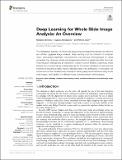Files in this item
Deep learning for whole slide image analysis : an overview
Item metadata
| dc.contributor.author | Dimitriou, Neofytos | |
| dc.contributor.author | Arandjelović, Ognjen | |
| dc.contributor.author | Caie, Peter D. | |
| dc.date.accessioned | 2019-11-29T10:30:04Z | |
| dc.date.available | 2019-11-29T10:30:04Z | |
| dc.date.issued | 2019-11-22 | |
| dc.identifier | 263809420 | |
| dc.identifier | ee937277-fdad-4b01-8bd1-5f5b11bda8b7 | |
| dc.identifier | 85076684294 | |
| dc.identifier | 000501254900001 | |
| dc.identifier.citation | Dimitriou , N , Arandjelović , O & Caie , P D 2019 , ' Deep learning for whole slide image analysis : an overview ' , Frontiers in Medicine , vol. 6 , 264 . https://doi.org/10.3389/fmed.2019.00264 | en |
| dc.identifier.issn | 2296-858X | |
| dc.identifier.other | Bibtex: 10.3389/fmed.2019.00264 | |
| dc.identifier.uri | https://hdl.handle.net/10023/19028 | |
| dc.description.abstract | The widespread adoption of whole slide imaging has increased the demand for effective and efficient gigapixel image analysis. Deep learning is at the forefront of computer vision, showcasing significant improvements over previous methodologies on visual understanding. However, whole slide images have billions of pixels and suffer from high morphological heterogeneity as well as from different types of artifacts. Collectively, these impede the conventional use of deep learning. For the clinical translation of deep learning solutions to become a reality, these challenges need to be addressed. In this paper, we review work on the interdisciplinary attempt of training deep neural networks using whole slide images, and highlight the different ideas underlying these methodologies. | |
| dc.format.extent | 7 | |
| dc.format.extent | 654951 | |
| dc.language.iso | eng | |
| dc.relation.ispartof | Frontiers in Medicine | en |
| dc.subject | Digital pathology | en |
| dc.subject | Computer vision | en |
| dc.subject | Oncology | en |
| dc.subject | Cancer | en |
| dc.subject | Machine learning | en |
| dc.subject | Personalized pathology | en |
| dc.subject | Image analysis | en |
| dc.subject | RC0254 Neoplasms. Tumors. Oncology (including Cancer) | en |
| dc.subject | QA75 Electronic computers. Computer science | en |
| dc.subject | SDG 3 - Good Health and Well-being | en |
| dc.subject.lcc | RC0254 | en |
| dc.subject.lcc | QA75 | en |
| dc.title | Deep learning for whole slide image analysis : an overview | en |
| dc.type | Journal item | en |
| dc.contributor.institution | University of St Andrews. School of Computer Science | en |
| dc.contributor.institution | University of St Andrews. School of Medicine | en |
| dc.contributor.institution | University of St Andrews. Sir James Mackenzie Institute for Early Diagnosis | en |
| dc.contributor.institution | University of St Andrews. Centre for Biophotonics | en |
| dc.contributor.institution | University of St Andrews. Cellular Medicine Division | en |
| dc.identifier.doi | 10.3389/fmed.2019.00264 | |
| dc.description.status | Peer reviewed | en |
| dc.identifier.url | https://www.frontiersin.org/articles/10.3389/fmed.2020.00419/full | en |
This item appears in the following Collection(s)
Items in the St Andrews Research Repository are protected by copyright, with all rights reserved, unless otherwise indicated.

